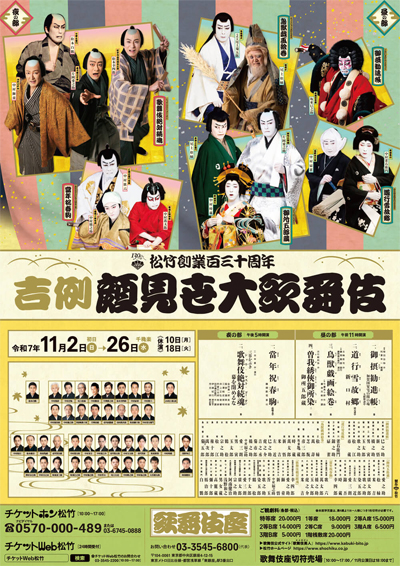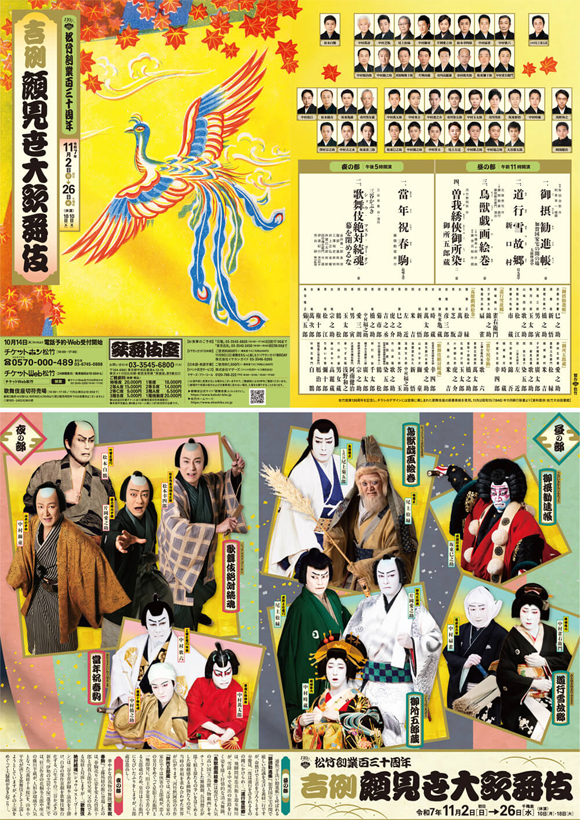| Casting |
Living National Treasure Onoe Kikugor˘, Living National Treasure Nakamura Karoku, Matsumoto Haku˘, Nakamura Manju, Nakamura Shikan, Nakamura Jakuemon, Matsumoto K˘shir˘, Kataoka Ainosuke, Nakamura Ganjir˘, Nakamura Senjaku, Onoe Sh˘roku, Nakamura Shid˘, Band˘ Yajűr˘, Nakamura Yonekichi, Band˘ Minosuke, Band˘ Hikosabur˘, Band˘ Kamez˘, Nakamura Tokiz˘,
Kataoka Ichiz˘, Ichimura Manjir˘, Kawarasaki Gonjűr˘, Nakamura Matsue, Ichikawa Omez˘, Sawamura S˘nosuke, Matsumoto Kingo, Ichikawa Komaz˘, Band˘ Shingo, Nakamura Kangyoku, Nakamura Tsurumatsu, Ichikawa Somegor˘, Nakamura Hashinosuke, Nakamura Toranosuke, Nakamura Mantar˘, ďtani Hirotar˘, Nakamura Fukunosuke, Nakamura Utanosuke, Onoe Sakon, Nakamura Tamatar˘, Ichikawa Otora,
Nakamura Kichinoj˘,
Asano Kazuyuki, Anan Kenji
|
| Comments |
The November Festive Face-Showing Grand Kabuki with only one program instead of the usual two programs: the Mitani Kabuki drama "Sh˘ Masuto G˘ On" ('The Show Must Go On').
this comedy was written by Mitani K˘ki in 1991 and premiered with his own theatre company, T˘ky˘ Sunshine Boys.
"Once the curtains are opened, they must never be lowered" - this play depicts the spirit and struggles of stage artists as they encounter one unfolding situation after another, and was a hit that was revived in 1994 and even produced for television. A renewed version was performed in 2022.
In 2025, the Kabuki adaptation is staged for the first time!
Ataka no Seki: "Gohiiki Kanjinch˘" was first performed in 1773 and is most famous for its comic
aragoto version of the famous play "Kanjinch˘"
(The Subscription List). As they are fleeing, the powerful warrior priest Benkei (Band˘ Minosuke)
gets his master Yoshitsune (Band˘ Shingo) through the barrier by pretending to be very weak and allowing himself to be
tied up. He cries like a baby when he is tormented by the barrier attendants.
But when Benkei decides that his master is safe, he explodes with energy,
showing off the bombastic aragoto style of acting.
He breaks the ropes and pulls off the heads of the attendants, tossing them into a barrel and washing them
like a bunch of potatoes. Featuring also Nakamura Hashinosuke (Togashi Saemon).
Michiyuki Yuki no Furusato:
(Travel Dance to Hometown in Snow)
A dance adaptation of the "Ninokuchi-mura" act of the drama "Koi Bikyaku Yamato ďrai".
In the pleasure quarters, the most important possessions were money and reputation. In danger of losing his lover, the courtesan Umegawa (Nakamura Jakuemon),
the money courier Kameya Chűbŕ (Nakamura Senjaku) breaks the seals on a
package of money entrusted to him after being taunted by a rival, even though the use of such money is punishable
by death. In this scene, on their way to love suicide, the couple go through the snow covered landscape on
their way to the man's home town where they will meet their end.
Ch˘jű Giga Emaki: This dance drama is set at the end of Heian period (12th century) in the mountains lying to the west of Kyoto.
While the monk Toba S˘j˘ (Living National Treasure Onoe Kikugor˘) paints and chats with the animals, scenes appear before him: the affectionate romance of a pair of frogs (Nakamura Manju/Nakamura Shikan),
a monkey-priest (Onoe Sh˘roku) showing off his power with vixens at his side, and a quarrel between frogs and monkeys.
This dance drama brings to life anthropomorphized animals, inspired by the famous National Treasure "Ch˘jű Jinbutsu Giga" ('Scrolls of Frolicking Animals and People'),
which remains popular even today. It will be staged as a Kabuki performance for the first time.
Gosho no Goroz˘: a portrait of the Yoshiwara
pleasure quarters at the height of its splendor. Rival gangs dressed
in the height of fashion exchange stately speeches before fighting
in the elaborate poetic cadences of Kawatake Mokuami, the last great playwright of Kabuki.
Goroz˘ is the handsome leader of a gang, but his lover, the top courtesan
Satsuki pretends to reject him to save his life. Tragedy strikes when Goroz˘
is driven to revenge. Starring Kataoka Ainosuke as Goroz˘, Onoe Sh˘roku as his rival in love,
Nakamura Tokiz˘ as Goroz˘'s lover, the courtesan Satsuki and Nakamura Yonekichi as ďshű,
a courtesan who is tragically killed.
Featuring also Matsumoto K˘shir˘ as Kabutoya Yogor˘.
Ataru Toshi Iwau Harukoma:
(Spring Hobbyhorses and the Soga Brothers)
The story of the revenge of the Soga brothers (sogamono)
is one of the favorite themes of Kabuki. Here it is transformed into a fanciful
dance using hobbyhorses, children's toys that were one of the sights of the
New Year. Starring Living National Treasure Nakamura Karoku, Nakamura Yonekichi, Nakamura Toranosuke, Nakamura Manju & Nakamura Hashinosuke.
Sh˘ Masuto G˘ On: at the H˘raiza Theatre in Ise,
playwright Hanagiri T˘gor˘ (Matsumoto K˘shir˘) and theatre manager Fujikawa Hanz˘ (Kataoka Ainosuke) plan to stage the popular puppet play, ĹYoshitsune Senbon Zakuraĺ
as a Kabuki play, with Yamamoto Koheiji (Nakamura Shid˘) in the starring role. But their efforts to mount the production soon spark a major commotion...
This play is based on 'The Show Must Go On': 'Maku o Oro-su na' ("Don't Drop the Curtain"), a legendary comedy originally written and
staged by playwright Mitani K˘ki for his own company, T˘ky˘ Sunshine Boys.
Celebrated as a masterpiece depicting the backstage world of the theatre, the work has been repeatedly revived to great acclaim.
Now it is being newly presented as Kabuki. Audiences can look forward to Mitaniĺs unique brand of laughter
and the unpredictable twists that unfold both onstage and behind the scenes, brought to life by a cast of colourful characters.
Featuring also Matsumoto Haku˘, Nakamura Ganjir˘ & Band˘ Yajűr˘.
Sources: Earphone Guide Website or Sh˘chiku Kabuki Official Website
|




